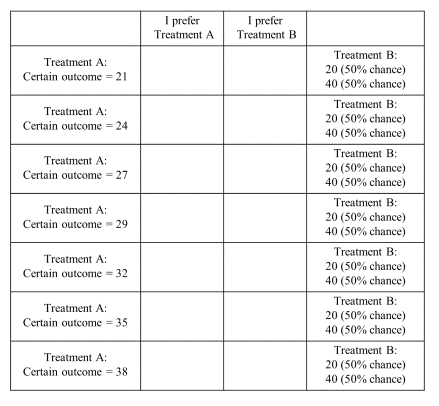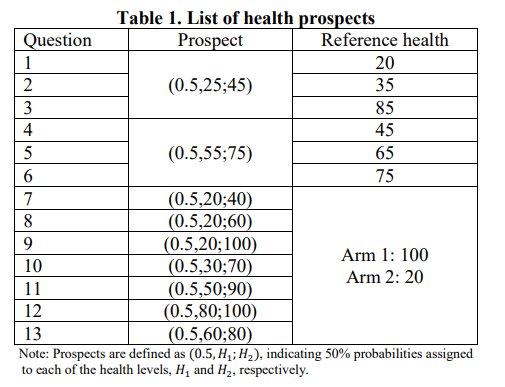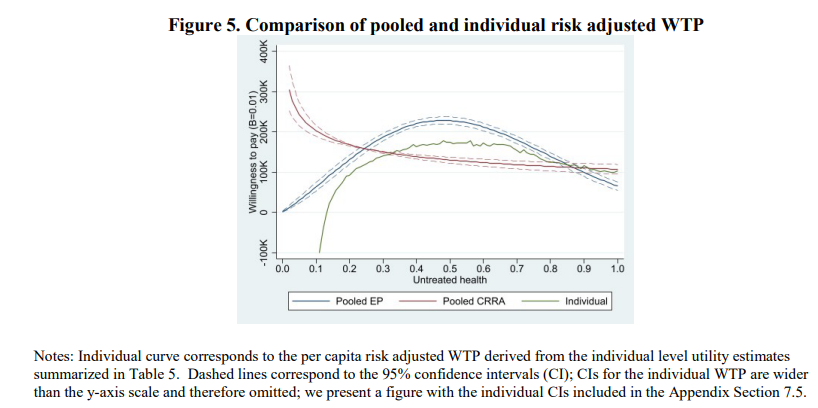
[ad_1]
Generalized risk-adjusted price effectiveness (GRACE) goals to include menace personal tastes into usual price effectiveness research (CEA) strategies. Whilst conventional CEA assumes people are menace impartial, GRACE permits for menace personal tastes to persuade cost. Particularly, that well being positive aspects in additional significantly in poor health well being states are valued greater than identical well being positive aspects in higher well being states. However a key parameter for estimating GRACE is understanding menace aversion estimates over high quality of existence results.
A contemporary NBER operating paper by way of Mulligan et al. (2023) supplies an means for doing this. Persons are provide with a definite high quality of existence and a menace one. The survey asks which one folks would like. This procedure is repeated the usage of other sure values. The use of this means, the authors calculated sure bet equivalents for each and every situation because the midpoint of the sure results between the 2 adjoining rows wherein a respondent switched from who prefer the dangerous remedy to who prefer the remedy with a definite consequence.


As soon as the knowledge identical is understood, one can then estimate a person’s software serve as. Baseline means used anticipated software idea assuming that reference well being does no longer subject, and the authors pooled knowledge for all respondents and questions. Additionally, the authors estimated software the usage of each a expo-power and loyal relative risk-aversion (CRRA) software purposes (see formulation beneath).




The use of this means, the authors to find that:
… folks showcase risk-seeking personal tastes at low ranges of well being, transfer to risk-averse personal tastes at well being equivalent to 0.485 (measured on a 0 to at least one scale), and change into maximum riskaverse when their well being is best possible (coefficient of relative menace aversion = 4.36). The danger choice estimates indicate an empirical top class for illness severity: each and every unit of well being is price 3 times extra to sufferers with critical well being prerequisites (well being equals 0.5) than those that are completely wholesome. Additionally they indicate that conventional CEA overvalues remedies for the mildest illnesses by way of greater than an element of 2. Use of conventional CEA each overstimulates delicate illness remedy innovation and underprovides serious illness remedy innovation.

Notice that those effects are delicate to specification. The expo-power serve as is parabolic formed the place delicate and really serious illnesses are over-value and slightly serious illnesses are undervalued. With CRRA, then again, the connection is monotonic (extra serious implies upper willingness to pay. The authors give an explanation for that this reversion of switching between being menace averse and menace loving on the lowest high quality of existence rankings is also because of coding gambles as positive aspects to losses (as is thought below prospect idea).
One advantage of the means is that authors are the usage of 0 to 100 well being states in order that high quality of existence can also be quantified. In follow, then again, respondents might or would possibly not have a excellent figuring out of what a top quality of existence of fifty way. One may just use precise well being states, however particular person might range on the subject of their valuations of those well being states.
This can be a pivotal and I indubitably suggest your learn the whole article right here.
[ad_2]